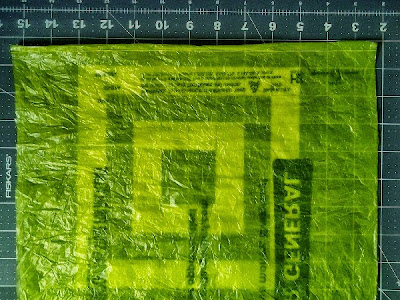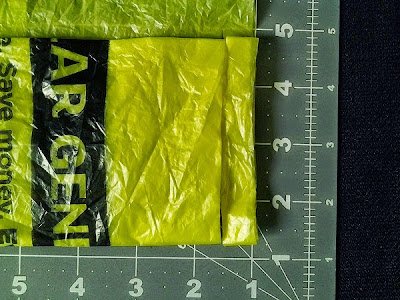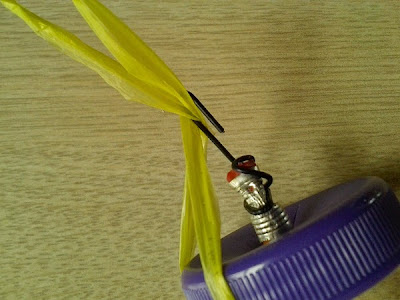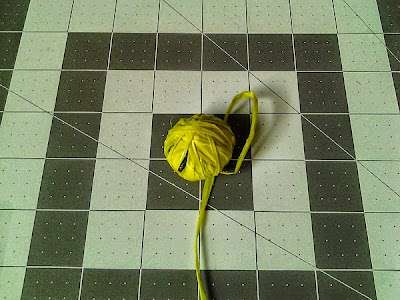I wanted to create plarn for more delicate projects, but had some difficulty working with it while joining strips. Follow along to learn a little bit about my trials with plarn, then get familiar with how to prepare the material for a thread-weight project.
To make plarn using the loop method, loops are cut from the body of the bag then ran through each other to create a knot. Because the loop method tends to be stronger, I tried it after cutting the plastic as thin as possible for a lighter weight plarn. The material is so weak this way that it often breaks when you try to tighten a knot, no matter how gentle you are with it. And then I discovered that the knots, which are usually unnoticeable in a heavier weight project, are very noticeable in a thread weight project and they catch on smaller steel hooks.
I went back to my preferred spiral method. Although there's nothing you can do to avoid the weakness of the plarn at this stage, you can cut it 1/2" to 3/4" (1.2 to 1.9 cm) wide, and try to avoid breaks when joining by being gentle with it. It can be worked with as-is, but if anything causes the slightest tug, the material will stretch or break. It's also very easy to accidentally push smaller hooks right through the plastic.
The answer to the problem was a drop spindle. Plastic yarn is fun and easy to spin, because you don't have as much of a problem with slubs or having fiber everywhere. The only thing you really have to worry about is not over-spinning the plarn, because it will snap quickly.
*A warning: I was sitting in a chair to spin, and had the spindle raised above head level. I over-spun the plarn, and it snapped right next to my face. The end of the broken plarn slapped me right in the eye, and it had quite a bit of velocity when it hit me. To top off my clumsiness, the spindle landed on my bare foot when it fell and gave me a nasty bruise. It's not like this is the most dangerous activity, but maybe I got hurt because I wasn't expecting any danger. So...like, don't poke your eye out or break your foot or anything, okay? Pay attention to what you're doing, and keep it away from your face.
Materials:
Grocery bags
Scissors or rotary cutter and cutting mat, or both
*It's difficult for me to use scissors because of a hand disability. I purchased a rotary cutter, and it has saved me so much time and effort! It took some time to get used to cutting bags with the cutter, but it was well worth it. A rotary cutter can at least save you some time with cutting off the tops and bottoms of the bags, even if you still use scissors for the spiral cutting. Having to keep the loops out from underneath the bag while cutting is a bit of a pain until you get the hang of it.
Directions:
For thicker plarn projects, it's okay to be a bit sloppy when cutting. Jagged edges or uneven spots blend in once worked up. When cutting bags for thread weight plarn, you need to be more careful. Try to get the bag smooth and cut as straight as possible. Pull the bottom seam straight, run the inside seams flat with your finger, and straighten the handles as best as you can.
*Tip: Most grocery bag handles turn inside out once filled and carried. If you handles aren't straight, they probably need to be turned in. Then you can perfectly line up the seams of the bag.
Cut off the top and bottom of the bag.
Unfold the seams, so the remaining body of the bag forms a tube. Flatten the bag out again.
The open ends should be on the sides, and the side seams will be the top and bottom. Fold up the bag from the bottom. Leave about 2" (5 cm) unfolded at the top. This unfolded section will be referred to as the "spine".
Starting from the bottom, cut a 1/2" (1 cm) strip, stopping once you are through the folded portion. Make sure you cut all the way through the fold, but do not cut through the spine.
Continue cutting strips of the same size until you reach the end of the bag. If there isn't enough, or too much material at the end to make an even strip, cut all the way through to the top to remove the final portion.
Unfold and straighten the strips. You will have a bunch of loose strips and the uncut spine at the top.
*Here is the difficult part if you use a rotary cutter. It isn't clear in this photo, but you will see how the strips are located underneath the spine. You will need to move them before every cut to avoid cutting through the material. Position the bag as shown in the photo, with the spine in the middle and the cut portions to each side.
If using scissors, you will be able to hold the bag in one hand while cutting with the other, so that the strips are open and there is no risk of cutting through them. Hold with the spine at the top, but slightly towards you, and the strips hanging down.
Follow the line in the photo for your first cut here. It will be a diagonal cut from the outer edge of the bag where the bottom strip meets the spine, to the inside of the first strip at the top of the spine.
Once the first cut is made, you will be able to "unravel" this strip from the body. It will now become part of the next strip at the bottom.
From this point on, no cuts will be made from the outer edge of strips. Cut from the inside of the bottom strip to the inside of the top strip.
This cut strip can be "unraveled" like the first. If you are using a rotary cutter, note how in this picture, you can somewhat see the outline of the bottom of the strips underneath the spine. Remember to pay attention! Move them out of the way by pushing them towards the uncut portion, or pull the next few strips out past where you are cutting.
Continue cutting in the same manner to the last strip. For the end strip, run your cut at the same angle as the rest, there just isn't another strip to cut into.
Now you have a big pile of plarn! With the material cut this thin, the plarn is very delicate, so try to keep it organized, and don't move it around too much. It's a real pain having to untangle the pile when it gets knotted up.
To spin the plarn, you can just twist it in your fingers while rolling it into a ball. This takes quite a long time to accomplish, though. A drop spindle can be very helpful.
If you don't have a drop spindle, follow this link to learn how to make one from simple household items, like the one I'm using.
Now, follow along to spin your material. Make a leader yarn out of some scrap plarn. Simply tie the material into a loop. This loop needs to be long enough to go from the under the round piece to over the hook.
Insert the shaft of the spindle into the leader yarn. Twist the leader one time, loop it over the spindle shaft for a slip knot.
Bring the other end of the leader yarn up behind the hook, then through it. You want to have at least one inch (2.5 cm) of a loop after the hook.
Run the end of the plarn you will be spinning through the loop of the leader yarn.
Twist the spindle counterclockwise to spin the plarn.
When the plarn has enough of a twist, remove it from the hook and wrap around the shaft of the spindle. Place the material back in the hook again; keep spinning.
If it twists tightly around itself (like shown) when you remove the plarn from the hook, you are spinning it too tightly. Let go of the spindle, holding the plarn, and let it untwist itself slightly until the kink is removed.
Roll it up into a ball, and you're done!
Well, almost done... It's really important to work up a gauge swatch before you go cutting up a bunch of bags. Grocery bags vary in thickness, so you can't guarantee that your plarn will match my plarn's weight.
Thread-weight crochet plarn is great for jewelry projects.
Check out these patterns using the same material:
Poinsettia Flower Brooch:
The bags used for this project were delicate boutique-style bags which were much thinner than the average grocery bag. You will see how it was necessary to cut the bags into 3/4" (2 cm) wide strips to obtain the same gauge.
Sunswirl Earrings
This pattern was made with plain ol' grocery bag plarn. The gauge is exactly equal to #10 crochet thread with the bag cut into 1/2" (1 cm) strips.
It's been a long time since my first tutorial for How to Make Plarn! The original version includes instructions for joining using the splice method.
To make plarn using the loop method, loops are cut from the body of the bag then ran through each other to create a knot. Because the loop method tends to be stronger, I tried it after cutting the plastic as thin as possible for a lighter weight plarn. The material is so weak this way that it often breaks when you try to tighten a knot, no matter how gentle you are with it. And then I discovered that the knots, which are usually unnoticeable in a heavier weight project, are very noticeable in a thread weight project and they catch on smaller steel hooks.
I went back to my preferred spiral method. Although there's nothing you can do to avoid the weakness of the plarn at this stage, you can cut it 1/2" to 3/4" (1.2 to 1.9 cm) wide, and try to avoid breaks when joining by being gentle with it. It can be worked with as-is, but if anything causes the slightest tug, the material will stretch or break. It's also very easy to accidentally push smaller hooks right through the plastic.
The answer to the problem was a drop spindle. Plastic yarn is fun and easy to spin, because you don't have as much of a problem with slubs or having fiber everywhere. The only thing you really have to worry about is not over-spinning the plarn, because it will snap quickly.
*A warning: I was sitting in a chair to spin, and had the spindle raised above head level. I over-spun the plarn, and it snapped right next to my face. The end of the broken plarn slapped me right in the eye, and it had quite a bit of velocity when it hit me. To top off my clumsiness, the spindle landed on my bare foot when it fell and gave me a nasty bruise. It's not like this is the most dangerous activity, but maybe I got hurt because I wasn't expecting any danger. So...like, don't poke your eye out or break your foot or anything, okay? Pay attention to what you're doing, and keep it away from your face.
*Don't worry if you don't have a drop spindle, I'll show you how to use a few simple household items to create one, when we get to that step.
Materials:
Grocery bags
Scissors or rotary cutter and cutting mat, or both
*It's difficult for me to use scissors because of a hand disability. I purchased a rotary cutter, and it has saved me so much time and effort! It took some time to get used to cutting bags with the cutter, but it was well worth it. A rotary cutter can at least save you some time with cutting off the tops and bottoms of the bags, even if you still use scissors for the spiral cutting. Having to keep the loops out from underneath the bag while cutting is a bit of a pain until you get the hang of it.
Directions:
For thicker plarn projects, it's okay to be a bit sloppy when cutting. Jagged edges or uneven spots blend in once worked up. When cutting bags for thread weight plarn, you need to be more careful. Try to get the bag smooth and cut as straight as possible. Pull the bottom seam straight, run the inside seams flat with your finger, and straighten the handles as best as you can.
*Tip: Most grocery bag handles turn inside out once filled and carried. If you handles aren't straight, they probably need to be turned in. Then you can perfectly line up the seams of the bag.
Cut off the top and bottom of the bag.
Unfold the seams, so the remaining body of the bag forms a tube. Flatten the bag out again.
The open ends should be on the sides, and the side seams will be the top and bottom. Fold up the bag from the bottom. Leave about 2" (5 cm) unfolded at the top. This unfolded section will be referred to as the "spine".
Starting from the bottom, cut a 1/2" (1 cm) strip, stopping once you are through the folded portion. Make sure you cut all the way through the fold, but do not cut through the spine.
Continue cutting strips of the same size until you reach the end of the bag. If there isn't enough, or too much material at the end to make an even strip, cut all the way through to the top to remove the final portion.
Unfold and straighten the strips. You will have a bunch of loose strips and the uncut spine at the top.
*Here is the difficult part if you use a rotary cutter. It isn't clear in this photo, but you will see how the strips are located underneath the spine. You will need to move them before every cut to avoid cutting through the material. Position the bag as shown in the photo, with the spine in the middle and the cut portions to each side.
If using scissors, you will be able to hold the bag in one hand while cutting with the other, so that the strips are open and there is no risk of cutting through them. Hold with the spine at the top, but slightly towards you, and the strips hanging down.
Follow the line in the photo for your first cut here. It will be a diagonal cut from the outer edge of the bag where the bottom strip meets the spine, to the inside of the first strip at the top of the spine.
Once the first cut is made, you will be able to "unravel" this strip from the body. It will now become part of the next strip at the bottom.
From this point on, no cuts will be made from the outer edge of strips. Cut from the inside of the bottom strip to the inside of the top strip.
This cut strip can be "unraveled" like the first. If you are using a rotary cutter, note how in this picture, you can somewhat see the outline of the bottom of the strips underneath the spine. Remember to pay attention! Move them out of the way by pushing them towards the uncut portion, or pull the next few strips out past where you are cutting.
Continue cutting in the same manner to the last strip. For the end strip, run your cut at the same angle as the rest, there just isn't another strip to cut into.
Now you have a big pile of plarn! With the material cut this thin, the plarn is very delicate, so try to keep it organized, and don't move it around too much. It's a real pain having to untangle the pile when it gets knotted up.
To spin the plarn, you can just twist it in your fingers while rolling it into a ball. This takes quite a long time to accomplish, though. A drop spindle can be very helpful.
If you don't have a drop spindle, follow this link to learn how to make one from simple household items, like the one I'm using.
Now, follow along to spin your material. Make a leader yarn out of some scrap plarn. Simply tie the material into a loop. This loop needs to be long enough to go from the under the round piece to over the hook.
Insert the shaft of the spindle into the leader yarn. Twist the leader one time, loop it over the spindle shaft for a slip knot.
Bring the other end of the leader yarn up behind the hook, then through it. You want to have at least one inch (2.5 cm) of a loop after the hook.
Run the end of the plarn you will be spinning through the loop of the leader yarn.
Twist the spindle counterclockwise to spin the plarn.
When the plarn has enough of a twist, remove it from the hook and wrap around the shaft of the spindle. Place the material back in the hook again; keep spinning.
If it twists tightly around itself (like shown) when you remove the plarn from the hook, you are spinning it too tightly. Let go of the spindle, holding the plarn, and let it untwist itself slightly until the kink is removed.
Roll it up into a ball, and you're done!
Well, almost done... It's really important to work up a gauge swatch before you go cutting up a bunch of bags. Grocery bags vary in thickness, so you can't guarantee that your plarn will match my plarn's weight.
Thread-weight crochet plarn is great for jewelry projects.
Check out these patterns using the same material:
Poinsettia Flower Brooch:
The bags used for this project were delicate boutique-style bags which were much thinner than the average grocery bag. You will see how it was necessary to cut the bags into 3/4" (2 cm) wide strips to obtain the same gauge.
Sunswirl Earrings
This pattern was made with plain ol' grocery bag plarn. The gauge is exactly equal to #10 crochet thread with the bag cut into 1/2" (1 cm) strips.
It's been a long time since my first tutorial for How to Make Plarn! The original version includes instructions for joining using the splice method.
Happy Crocheting!

































Comments
Post a Comment
This is not a political website. Any comments with political content will be removed. Y'all need to learn how to act right.